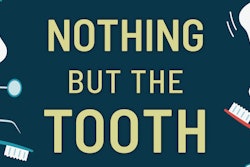
In everyday life, conflicts inevitably arise, perhaps even more so in our current anxiety-filled environment. Jobs, health, and futures are uncertain as we navigate the COVID-19 crisis. In the dental setting, conflicts usually originate from unmet expectations, billing disputes, or perceived power differences where the patient does not feel respected by the dentist. Almost all conflicts have this in common: a breakdown in communication.
What steps can we take to prevent conflict?
Patient selection
 Dr. Teresa Yang.
Dr. Teresa Yang.It begins with patient selection. Does the patient complain about the last six dentists he's seen? If that's the case, why do you think you can satisfy him? Does the patient treat the front office staff rudely while being cordial to you? Should a dispute arise, the patient may begin to speak to you as disrespectfully.
If the patient has a mouthful of long-term, broken-down provisional restorations, explore the reasons why. Did she leave a previous dentist for nonpayment? Why did the patient not follow through to treatment completion? Or is she wearing temporaries because of challenging occlusal or neuromuscular issues that may be beyond your level of expertise? Some patients have highly unrealistic expectations, bringing in photos of perfect teeth that you may be unable to recreate.
Just as a restaurant can reserve the right not to serve a patron, you, too, can decline to treat a case.
Expectations
If you do decide to accept a patient, begin by understanding his or her expectations. Ask open-ended questions and listen for the answers. Summarize the patient's wishes and goals, then seek agreement. Perform a comprehensive examination, including radiographs, models as indicated, photos, necessary medical consults, and a thorough clinical evaluation. In esthetic cases, where, for example, "white" might not mean the same thing to you and the patient, ask the patient to bring in photographs of the desired outcome.
Once you understand what the patient wants, you can correct any unrealistic expectations. For instance, the patient may want straight teeth but will only agree to aligner orthodontics. In your evaluation, you determine ideal occlusion and esthetics cannot be achieved by these means. How do you convey that the result will not be perfect? Will the patient even remember your predictions months later? Or do you pass on the case?
Information
Now is also the time to provide concrete information. Explain the procedure in terms the patient will understand. Detail the timeline and costs. Discuss any postoperative symptoms and how much discomfort there may be throughout the process. Explain how long the patient will be in provisionals and what function will be like with regard to eating and speech. Involve your auxiliaries in this discussion. Often patients will ask dental assistants questions they may be reluctant to ask you.
Worst-case scenarios
Describe worst-case scenarios. Patients don't want to hear that they need an extraction when they thought they were getting a crown. But if you point out the preexisting fracture beforehand and say the crown may stabilize and maintain the tooth, then when the crown is successful, you will be the hero because you saved the tooth.
Ask the patient if he or she has any deadlines. For example, the patient may be anticipating new teeth just in time for an important meeting or family function. Yet all dentists have experienced situations where unacceptable final restorations have to be remade and result in a delay.
Informed consent
All this dialogue and information is part of the critical and essential informed consent. More than a signature or a document, the informed consent is a process. For routine and mundane procedures, such as a simple prophylaxis, sometimes implied consent is sufficient. But when in doubt, write out a specific informed consent.
Treatment
Once you're ready to treat, perform quality treatment. Don't practice outside your comfort zone or allow your ego to dictate case selection. Refer to specialists or other colleagues when indicated. Know how to manage postoperative complications and, again, refer when necessary. Maintain good relationships with specialists, as they are a useful resource and often ready to help. Commit to the importance of continuing education. The more you learn, the more there is to learn.
In esthetic cases, seek the feedback of significant others, as patients will look to them for confirmation that their smile is beautiful.
Documentation
Lastly, thorough documentation will provide evidence in case a conflict arises. An example of an acceptable chart note is provided:
1/6/15 Pt. seen with cc pain LL quad. Severe, increasing over 1 week. Exam shows extensive caries,1 pa & 1 bw x-ray probable endo. Advise patient. Signed informed consent. 1 carp. Lido.1:100000. Isolate w dam, excavate, carious exposure. Control 22mm file, shape to 35g, irrigate w NaCl & H2O2. seal one canal w sealer & warm gutta percha. Temp cavit.
The entry details the subjective complaints, objective findings, and diagnosis and action, and it summarizes the procedure. Note the commonly accepted abbreviations. If immediate alterations are necessary, cross out the original entry with a single line and enter the correct information. If after-the-fact alterations or amendments are needed, write a new entry, dated, and enter the correct information, all without touching the original entry. Supplement with photographic and radiographic documentation. Use your judgement in delegating this vital task.
For digital entries, the same principles apply. In addition, take note of who is signed in when entering chart entries. Also, be careful about using strictly preset words and phrases, as you may be leaving out pertinent information.
Remember, the patient chart is a legal document. In the event of a complaint or lawsuit, if it wasn't written down, it didn't happen.
In my next article, I will address how to manage patient conflicts.
Dr. Teresa Yang started two practices from scratch and sold them both. She currently serves as a trustee at the California Dental Association (CDA) and is a member of the CDA Foundation Board. She is also the editor of WestViews at the Western Los Angeles Dental Society. Her general interest articles have been published in online literary journals and on humor sites. She can be reached at [email protected].
The comments and observations expressed herein do not necessarily reflect the opinions of DrBicuspid.com, nor should they be construed as an endorsement or admonishment of any particular idea, vendor, or organization.



















